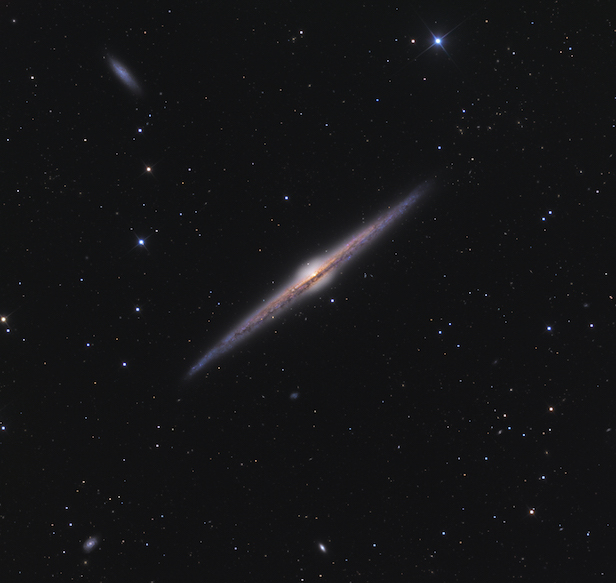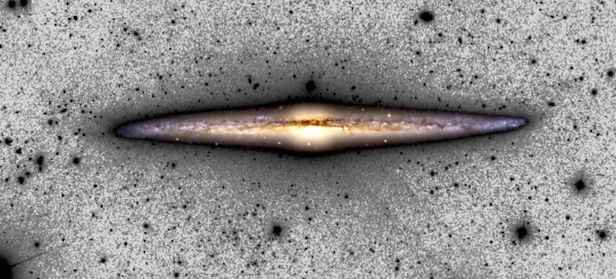Astronomers suggest the Milky Way could be growing every day
When observing galaxies very similar to the Milky Way, researchers have deduced that they are slowly expanding in size

NGC 4565 is a spiral galaxy with a edge-on view of its disc, making it an ideal target of research for this study. Image credit: K. Crawford
The Milky Way, the barred-spiral galaxy in which we live, could well be growing in size. This discovery, announced recently at the European Week of Astronomy and Space Science meeting in Liverpool, UK, came from a study led by Cristina Martínez-Lombilla, a PhD candidate at Instituto de Astrofísica de Canarias. By observing other galaxies similar to the Milky Way, they observed galaxies slowly swelling at a rate of approximately 500 metres (0.3 miles) per second.
The Solar System is situated between 26,000 to 28,000 light years from the Milky Way’s core, in one of the spiral arms known as the ‘Orion Arm’. The whole diameter of the Milky Way is about 100,000 light years, and it accommodates several billions of stars, as well as gas and dust. All this material rotates around the galactic core because of its enormous gravitational effect.
It is gravity that determines the shape of a galaxy, and this can mould the galaxy into either a spiral, elliptical or irregular galaxy. The Milky Way is a barred-spiral galaxy, meaning that the galaxy has a disc of stars, dust and gas rotating in spiral arms originating from a central bar that pierces through the galactic bulge.
There is a wide variety of stars residing in the Milky Way, ranging from young, enormous, blue stars that will only survive a few million years, to older, lower-mass, redder stars that last for hundreds of billions of years. Based on previous observations, the younger stars tend to be found more in the spiral arms of a barred-spiral galaxy, whereas the older stars dominate the bulge and the galactic ‘halo’, which is the area hovering above and below the disc.
There are star-forming regions found at the outer edges of these galactic discs, and astronomical models have predicted that the stars created in these regions will slowly increase the size of their host galaxy. The issue with applying this knowledge to our galaxy is that we live inside of it, so we cannot gain a full picture of it. In this case, astronomers have to observe galaxies similar to the Milky Way in an attempt to relate the findings to our home galaxy.

A composite image of NGC 4565 was used in the study. Image credit: C. M. Lombilla / IAC
In order to study the appropriate spiral galaxies as they slowly expand, astronomers have been gathering optical data from the ground-based Sloan Digital Sky Survey (SDSS) telescope, and near-ultraviolet and near-infrared data from two space-based telescopes, Galaxy Evolution Explorer (GALEX) and NASA’s Spitzer telescope. This combination of data at different wavelengths supplied the researchers with information regarding the colours and motions of the stars at the end of the disc.
By predominantly observing the vertical motions of young blue stars in the outer regions, researchers determined how long it would take for these stars to move away from their birthplace, and how their host galaxy is growing in size. The calculations have led researchers to believe that galaxies similar to the Milky Way are expanding at a rate of approximately 500 metres (0.3 miles) per second. This is the equivalent of travelling from Liverpool to London, both in England, in about 12 minutes.
“The Milky Way is pretty big already, but our work shows that at least the visible part of it is slowly increasing in size, as stars form on the galactic outskirts,” says Martínez-Lombilla. “It won’t be quick, but if you could come back and look in 3 billion years’ time the galaxy would be about 5 per cent bigger than it is today.”
However, this rate of galactic growth could well be unimportant in the distant future. This is because astronomers have also made it known that the Milky Way and our nearest galactic neighbour, the Andromeda Galaxy, are gravitationally bound and on a collision course. Within about 4 billion years, the two galaxies will apparently collide causing turmoil to both their shapes while instigating a wave of intense star formation.
Keep up to date with the latest reviews in All About Space – available every month for just £4.99. Alternatively you can subscribe here for a fraction of the price!




